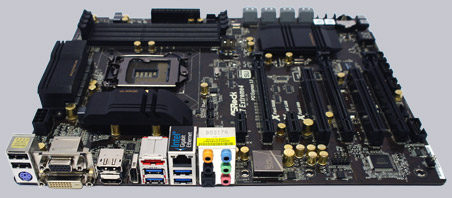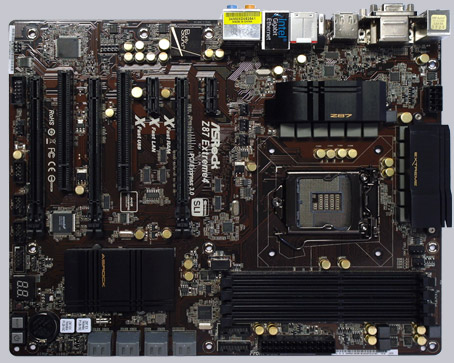
Result and general impression

++++ The ASRock Z87 Extreme4/M/ASR motherboard has a price of approx. 130 Euro (08/2013) and is thus in the middle price segment of the Intel LGA 1150 Haswell motherboards.
Today we test the new ASRock Z87 Extreme4 Intel LGA 1150 motherboard at OCinside.de. It is based on the Intel Z87 chipset and offers a high-quality solution for current 1150-pin Haswell processors like the Intel Core i7-4770K, Intel Core i5-4570 or the Intel Core i5-4670K, which we have used to test and overclock this motherboard. Surely only a few motherboards can compete with the recently tested ASRock Z87M OC Formula when overclocking, but the basic equipment of the ASRock Extreme series sets definitely new standards. The ASRock Z87 Extreme4 offers for example a total of five PCI Express slots, up to nine USB3.0 ports, eight SATA3 ports, eSATA3, DisplayPort, 15-pin D-Sub, DVI-D, HDMI out, HDMI in and purity sound with digital sound output over an optical S/PDIF output. We may be curious to see all results of the ASRock Z87 Extreme4 in the following review.
The ASRock Z87 Extreme4 LGA 1150 motherboard is delivered in this cardboard box:
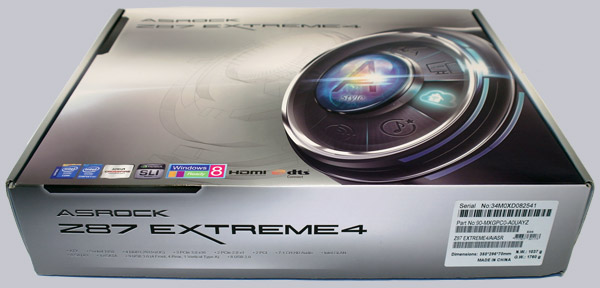
Here is a first look inside of the ASRock mainboard carton:
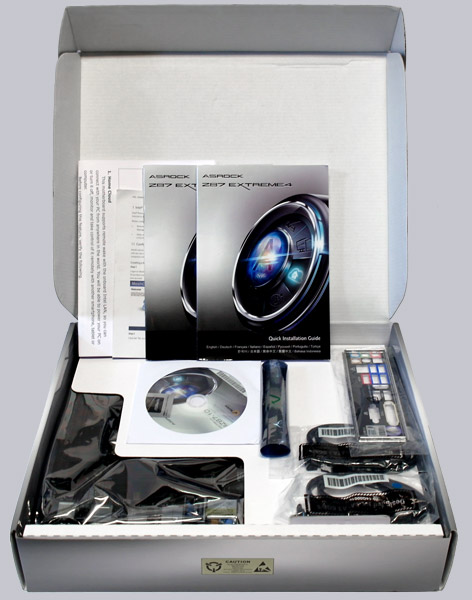
The board was carefully wrapped for safe delivery with foam and fastened with cable ties:
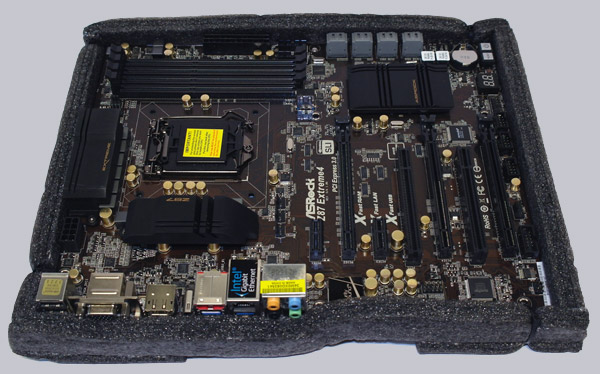
The ASRock Z87 Extreme4 board is is very well finished and has durable Premium Gold Caps Conductive Polymer capacitors, offers Digi Power VRM and 12 Power Phase Design, Distortion-Free Slots and Purity Sound:
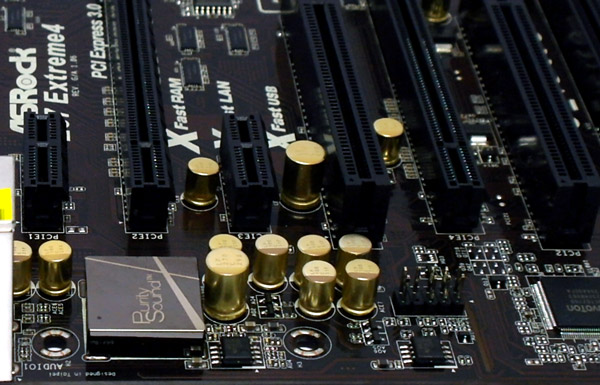
Here we can see the Dr. Debug 7-segment LED post code display, the LED illuminated power and reset button, the two UEFI BIOS ICs and the ASMedia ASM1083 PCI Bridge IC:
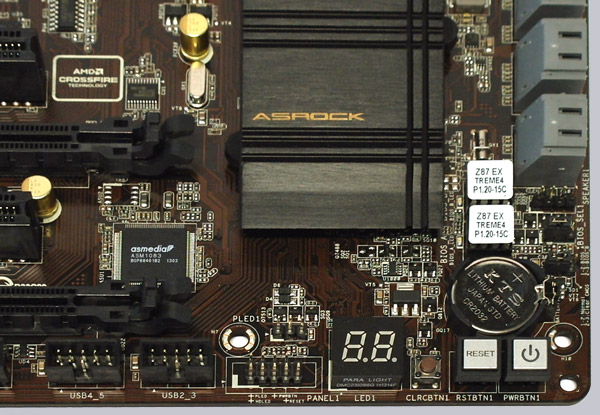
Here we can see both USB 3.0 headers and the additional internal USB-A port in the upper left corner of the picture, which is controlled by the ASMedia ASM1061 IC:
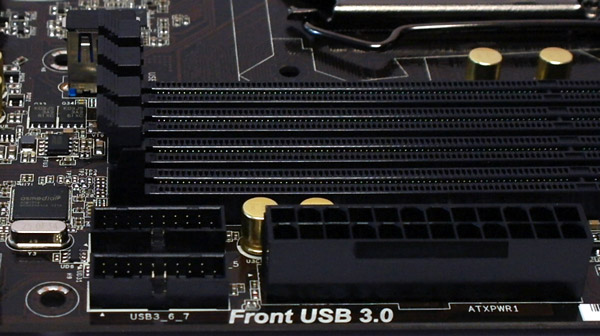
Equipment and other features …
The ASRock Z87 Extreme4 motherboard came with a manual, software setup guide, one DVD, four SATA data cables, a SLI bridge and one ATX I/O shield. USB Slot brackets or the ASRock 3.5-inch USB3.0 frontpanel are optional available.
TheASRock Z87 Extreme4 offers a lot of features like for example the ASRock A-Tuning Tool, ASRock Instant Flash, ASRock Internet Flash, ASRock APP Charger, ASRock Fast Boot, ASRock Restart to UEFI, ASRock XFast USB, ASRock XFast LAN, ASRock XFast RAM, ASRock Crashless BIOS, ASRock Online Management Guard, ASRock UEFI System Browser, ASRock Dehumidifier Function, ASRock Easy RAID Installer, ASRock Easy Driver Installer, ASRock interactive UEFI, ASRock Good Night LED, ASRock USB Key, ASRock Home Cloud, Purity Sound, HDMI-In, 12 Power Phase Design, ASRock FAN-Tastic Tuning and the ASRock Distortion-Free Slots.
Expansion cards …
The AMD CrossFireX / nVidia SLI motherboard offers three PCI Express 3.0 video card slots, whereby either one video card can operate with x16 band-width, or two with x8 lanes or one with x8 band-width and two with x4 lanes. A CrossFire bridge is included in the motherboard box, another special SLI/XFire switch card is not necessary to get the optimal performance for single or CrossFireX operation. If one like only use one video card on the Z87 Extreme4, one should insert the PCI Express video card into the PCIE2 slot, in order to get the fastest x16 bandwidth. Additionally to the three PCI Express 3.0 slots there are two x1 PCIe 2.0 slots and two PCI slots.
Memory …
The ASRock Z87 Extreme4 can be equipped with up to four DDR3 modules and is expandable depending upon operating system used (see list) to maximally 32 GB memory.
Here is a picture of the four DDR3 memory slots with dual channel support (A2+B2 / A1+B1):

The Intel LGA1150 motherboard supports DDR3 memory modules and can be optimized in the BIOS for DDR3-1600 Dual Channel modules with an Intel Haswell processor. DDR3-1866, DDR3-2133, DDR3-2400, DDR3-2800, DDR3-2933, DDR3-3000 or higher clock-rates are currently only possible with overclocking. Thanks to XMP support (Intel eXtreme Memory Profiles), XMP memory modules be set correctly with one mouse click in the UEFI. There are of course far more memory adjustments and even higher overclocking features, but more on that later. You can also check the officially supported modules at ASRock’s memory support page.
Hard disk drive connectors …
The ASRock Z87 Extreme4 offers eight SATA3 connectors (6 Gb/s) and one eSATA3 port at the I/O Panel, where two bended SATA3 ports and the eSATA3 port is managed by the additional ASMedia ASM1061 chip.
Here you can see the six SATA3 ports:
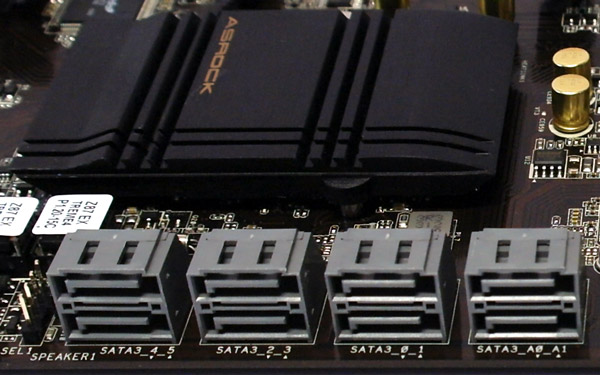
The SATA3 ports supports RAID 0, RAID 1, RAID 5, RAID 10, Intel Rapid Storage Technology 12 – RST12 and Intel Smart Response Technology, NCQ, AHCI and the Hot Plug function in AHCI mode (AHCI stands for Advanced Host Controller Interface and can be selected in the UEFI). Thanks to UEFI BIOS also drives with more than 2 TB for the installation of Windows 8, Windows 7 x64 or Vista x64 can be used.
The manual and the included DVD contains all basic information to manage a new installation of Windows Vista, Windows 7 or Windows 8 with SATA3 drives, and how to manage a RAID installation. 32-Bit and 64-Bit drivers for Windows 8 and Windows 7 are provided on the DVD and can be downloaded on the ASRock support page.
USB and Firewire …
The board has nothing less than four USB 3.0 connectors at the ATX-panel, two more USB 2.0 connectors at the ATX panel, three internal USB 2.0 plugs for up to six optional USB ports and two more internal USB 3.0 plugs for up to four optional USB3 ports. The 20-pin connector can be connected either to an optional USB3.0 front panel or to an enclosure with USB3.0 ports.
Another feature of this motherboard is the additional internal USB-A 3.0 port that is integrated directly on the mainboard and can be reached internally within the PC case. This is often very useful, e.g. for an internal connection of an USB Ultra IR receiver kit, an USB memory stick or for an UMTS stick. However you should be careful using this USB port and always look where you exactly stick the USB, as internal connections usually are equipped with plastic connectors, to avoid an accidental short circuit with exposed contacts.
Hint: One should install the latest ASRock XFast USB software to accelerate the USB transfer rate e.g. for USB sticks clearly. Who uses Windows 7 or Windows 8, should also install the ASRock XFast RAM software, which we have discussed already several times in some forum posts.
Network …
The ASRock Z87 Extreme4 motherboard is provided with the Intels I217V solution, which offers a 10/100/1000 network connector on the I/O panel. The LAN connection is WoL capable, offers LAN cable detection, supports energy efficient 802.3az ethernet and supports Intel Remote Wake Technology.
Serial and parallel port …
This motherboard does not provide a parallel port. The serial port is optionally available as internal connector on the motherboard.
Sound …
The ASRock Z87 Extreme4 motherboard is equipped with the ALC1150 audio codec with content protection, 115dB SNR DAC, TI NE5532 Premium Headset Amplifier and Purity Sound, which supports 7.1 surround sound for example analog over 5x 3.5mm connectors on the ATX panel or over an internal frontpanel audio connector. Furthermore, there is an optical digital SPDIF output, THX TruStudio support and premium Blu-Ray audio support. So most users do not need to buy an additional sound card with digital outputs.
Graphics …
The new Intel Z87 chipset offers in combination with an Intel Haswell processor a full integrated Graphics Technology (GT) graphics solution with DX11 support. Depending upon processor used, there is another graphics unit, whereby the Intel Core i5-4670K CPU used in this test is equipped with the HD Graphics 4600.
A very special feature of this Z87 Extreme4 motherboard is the additional HDMI-In port, which allows the connection of an external HDMI device like another PC, a cable or satellite receiver or a Smartphone with HDMI output:
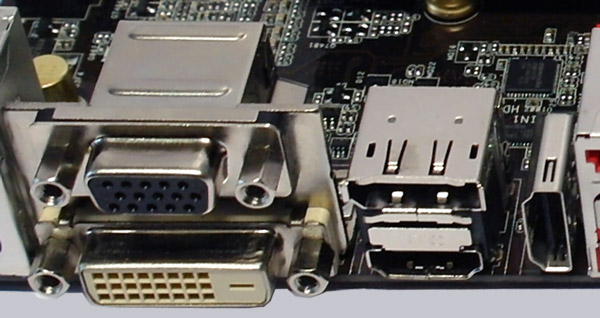
Of course we have also tested this nice feature as well and could switch between the PC picture and the external HDMI device during operation using the key combination ALT + C, which can be changed with the A-Tuning program in HDMI-IN -> Hotkey:
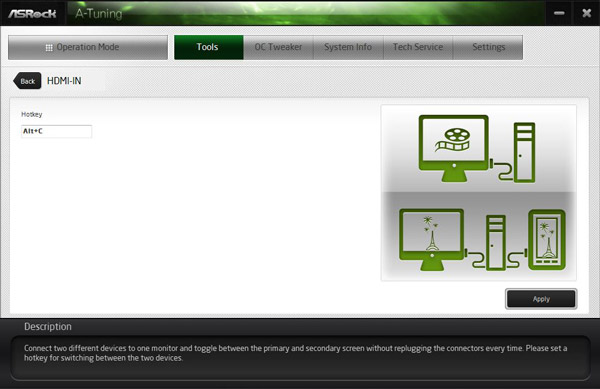
Over UEFI setup,the graphics unit can be overclocked from 1200 to 3000 MHz, but the Intel HD Graphics 4600 GPU has even without overclocking an awesome performance. So the GPU of the Intel Core i5-4670K CPU achieved in Windows 7 with 3DMark 48084 Ice Storm points, with 3DMark11 Entry 2569 3DMarks and with 3DMark06 7892 3DMarks !
In comparison, the AMD HD7660D GPU of an AMD A10-5800K APU reached on the ASRock FM2A85X Extreme6 in 3DMark06 7651 3DMarks, the HD6550D GPU of the AMD A8-3870K FM1 APU reached on the ASRock A75 Pro4 motherboard 6181 3DMarks, an Intel HD Graphics Unit of the Intel Core i5-2500K CPU on an ASRock H77 Pro4/MVP achieved with 3DMark06 in Windows 7 a benchmark score of 4310 3DMarks, an AMD HD 4290 IGP of the AMD 890GX chipset achieved with an AMD Phenom II 710 X3 processor on an ASRock 890GX Extreme4 a 3DMark06 score of 2204 points. Furthermore the integrated video processor supports DirectX 11, HDCP, Full HD 1080p and offers thanks to its onBoard HDMI connector and the low power consumption optimal conditions for an overclocker Gaming PC.
ATX backpanel connectors …

From left to right, one can see 2x USB 2.0 ports, the PS/2 connector for a PS/2 keyboard, 15-pol Sub-D VGA and DVI-D VGA, DisplayPort and HDMI Out, HDMI In, eSATA3 and 2x USB 3.0, RJ45 Gigabit LAN and 2x USB 3.0, optical SPDIF out and 5x 3.5mm jacks for analog sound.
BIOS and Overclocking …
Let us continue with BIOS / UEFI Setup options and the UEFI overclocking. By pressing F2 or Del during the PC boot, you get access to the UEFI Setup.
The ASRock UEFI BIOS of the Z87 Extreme4 offers a graphical surface for an intuitive operation with a mouse or with a keyboard, depending upon desire. User with an USB mouse and USB keyboard should not deactivate the Legacy USB support in the BIOS with the USB Configuration, because otherwise they can not access the UEFI Setup. In the Auto mode the board decides if the USB device need to operate in Legacy mode. Keyboard and Mouse should be still connected to the USB 2.0 ports.
Another feature is the “Active Page on Entry” selection, where you can decide which UEFI page you want to see, when you enter the UEFI Setup. This is very helpful mainly for overclocking since one have to enter the second OC Tweaker menu very often to find the best OC settings. So ASRock helps you to save some mouse clicks.
Here you can see the Z87 Extreme4 UEFI surface with the active page on entry menu:
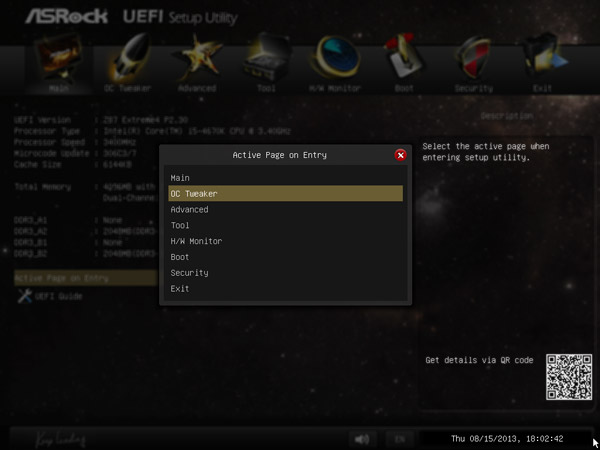
UEFI BIOS Update …
ASRock offers several ways to update the BIOS and one very comfortable option to flash BIOS updates is the so-called ASRock Instant Flash or ASRock Internet Flash with direct access to the internet.
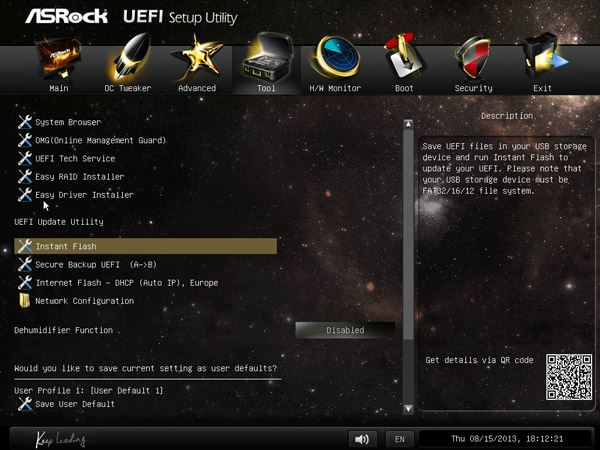
One can enter the ASRock Instant Flash utility in the Advanced Screen or by pressing F6 during the PC start. Hereby one can upgrade a downloaded ASRock BIOS without further boot CD, USB boot stick, etc. very easily. Just start the ASRock Instant Flash utility and select a BIOS Flash ROM from the device like an USB Stick to flash the BIOS without an additional boot medium. If you need technical help about the UEFI, you can contact the ASRock over the UEFI Setup and LAN connection. Furthermore, this motherboard is equipped with a backup BIOS and by the “Secure Backup UEFI” option one can update with a working BIOS from the other BIOS EEPROM and select the preferred BIOS chip at any time over the BIOS selection jumper.
The motherboard came with BIOS M1.61E. At review date, the UEFI BIOS Version P2.30 was the latest version for download:
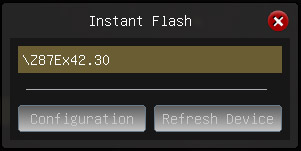
How to overclock the ASRock Z87 Extreme4 motherboard …
The Z87 Extreme4 UEFI Setup offers versatile OC-settings for easy overclocking. For the DDR3 memory, this board supports settings like e.g. the memory frequency from DDR3-1066 over DDR3-1333, DDR3-1600, DDR3-1866, DDR3-2133 up to amazing high DDR3-4000. With BCLK overclocking are even higher RAM overclocking results possible.
Here you can see the DDR3 frequency selection at default 100 MHz BCLK:
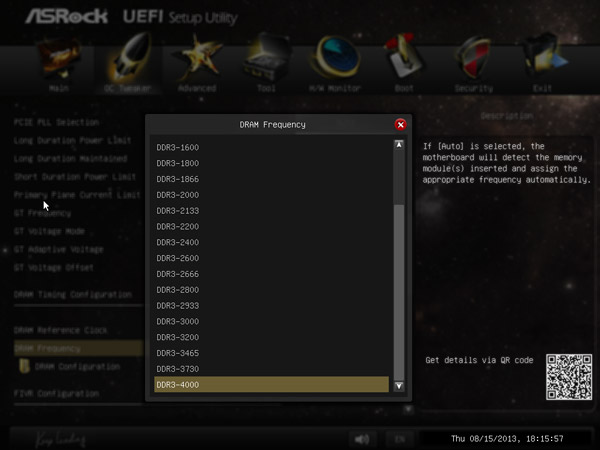
The frequency of all memory modules is calculated and displayed after changing the reference clock to make it much easier adjusting to the right RAM frequency. Up to DDR3-4000 can be selected in the BIOS and higher DDR3 frequencies above DDR3-4000 are possible with manual overclocking over the BCLK. Thanks to the XMP support, XMP memory modules ca be set correctly with one mouse click in the UEFI, selecting the desired profile in the DRAM configuration. But this Z87 Extrem4 offers much more …
In the DRAM Tweaker menu, you get a very good overview of all the values to choose from:
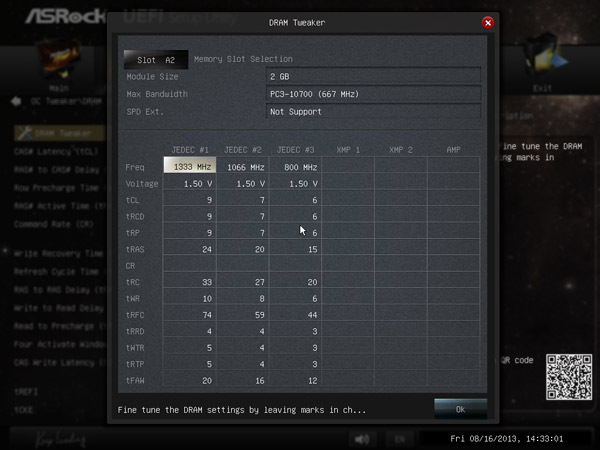
For CPU overclocking, ASRock offers a clearly arranged OC Tweaker menu in the UEFI Setup. Here you can see a snippet of the great OC Tweaker settings:
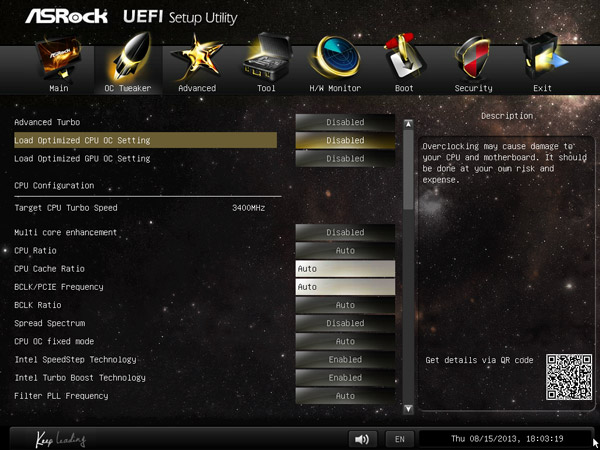
In this menu one can set the BCLK/PEG frequency from 90 MHz to 300 MHz. This frequency is very important for a lot of frequency values with Intel Haswell processors as well as already known from Sandy Bridge and Ivy Bridge processors, which can get quickly too high. For this reason, you should carefully increase the BCLK host clock and also adjust the BCLK ratio, to increase it to 125 MHz, 167 MHz or even higher.
In the review the motherboard could be stable overclocked on a BCLK of 170 MHz.
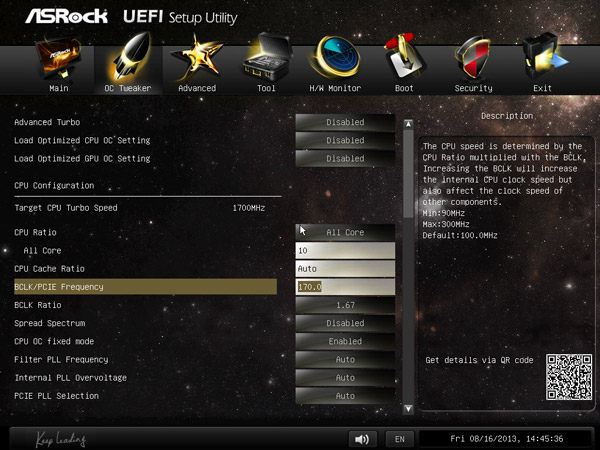
Buyers of an Intel “K” CPU have an unlocked multiplier and may want overclock the CPU frequency very extensively over the CPU multiplier. With a 4670K CPU (default clock 3400 MHz with a CPU ratio of 34x), the ASRock Z87 Extreme4 motherboard offered a multiplier range from 8x to 120x.
The GPU clock of the integrated graphic unit can be adjusted from 1200 to 3000 MHz.
The boot failure guard was also examined in the test and could start the PC even at high Übertaktungswerten without CMOS clear with standard frequencies. ASRock leaves the user with the “Boot Failure Guard Count” Option which will boot choice, how often the board should boot with fault settings before it automatically reduces the frequencies. If it accidentally succeeds that the PC fails to boot, you can also set the CMOS clear button, the stored values in the profile fortunately remain and can be loaded very fast.
Furthermore, the Board has a lot of voltage settings like for example a Vcore selection with the Intel Core i5-4670K Test CPU of 0.800 up to 2.000 Volt and +0.001 to +1.000 offset, an IGPU voltage of 0.800 to 2.000 Volt and GT voltage offset between +0.001 and +1.000 Volt, PCH 1.05V chipset voltage between 0.977 – 1,322V, PCH 1.5V I/O voltage 1.369 to 1.639 Volt, System agent voltage offset +0.001 to +1.000 Volt, CPU cache voltage of 0.800 up to 2.000 Volt and +0.001 to +1.000 offset, CPU input voltage 1.200 – 2.300V, CPU analog IO voltage offset from -1.000 to +1.000, CPU digital IO voltage offset -1.000 to +1.000, primary plane current limit, Short Duration power limit, Long Duration power limit, Internal PLL Overdrive voltage, PCIE PLL selection, CPU Load Line Calibration from 1 to 5 and more boost options that allows more room for overclocking.
The DDR3 voltage could be increased in the BIOS between 1.165 and 1.800 Volt, which should be enough voltage even for DDR3 OC modules.
If these are too many values for you or if you do not like to get deeper inside of overclocking, one can also Load Optimized CPU OC Settings, to try overclocking with predefined OC settings. They can increase the system performance automatically by overclocking in different Turbo steps – at least with some luck and if it is possible with your components. Simply select the desired boost setting, then some components and the CPU are overclocked, e.g. to a desired value of Turbo 4.0 GHz, Turbo 4.2 GHz, Turbo 4.4 GHz or Turbo 4.6 GHz. Then you might also Load Optimized GPU OC Setting for the iGPU to 1500 MHz, 1600 MHz or 1700 MHz – that is easy overclocking! However, you should set each value manually, to be able to adjust all values in detail for the respective hardware.
We will give you overclocking help in our PC Forum (German and English).
When you find the right values for your system, you can store up to three different BIOS settings with a desired name. Thus one can save for example balanced BIOS settings, overclocking settings and underclocking settings in a user profile of the UEFI to load them very quickly at any time.
Here is a screenshot of the user profiles:
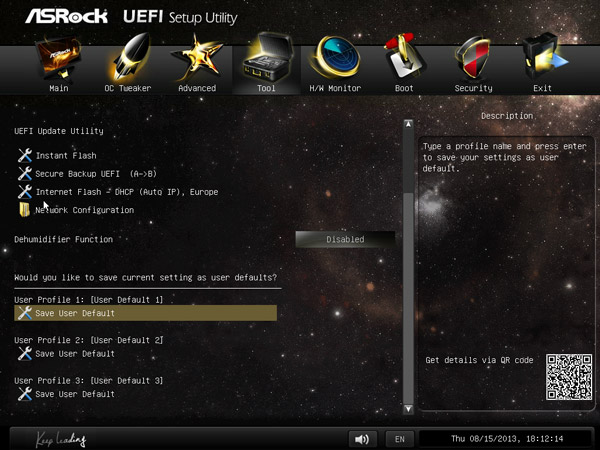
BIOS Undervolting …
The downclocking or underclocking was also tested in this review. It was possible to lower the Intel Core i5-4670K CPU multiplier over the BIOS to 8x and the processor can be underclocked in such a way with 95 MHz BCLK to approx. 760 MHz. Underclocking is like OverClocking outside of the manufacturers specification, so it is necessary to have a bit luck, but ASRock gives several options for easy PC underclocking / downclocking.
The UEFI Setup of the passive cooled Z87 Extreme4 motherboard offers a CPU Quiet Fan option (temperature fan control) for a 4-pin CPU fan, a 3-pin CPU fan and the 4-pin chassis fan 1 and 3. Chassis fan 2 can be adjusted manually in 4 steps. Since the fans are temperature controlled, it is not very necessary to buy an additional fan controller.
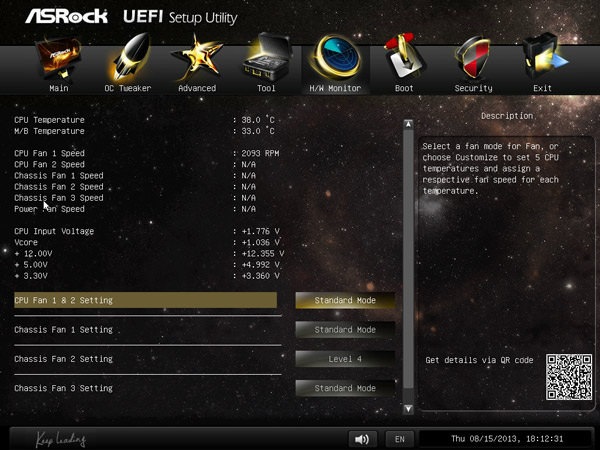
The fan control can also easily set using ASRock’s A-Tuning Tool supplied. Here is a screenshot of the FAN-Tastic Tuning page:
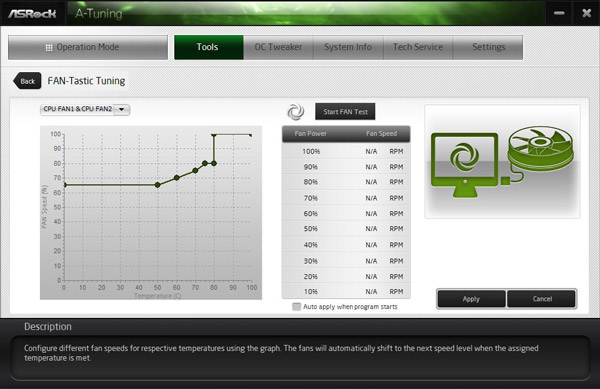
The ASRock A tuning software provides some additional tools, such as the temperature monitoring and some OC settings in the OC Tweaker menu. At ASRock you can download also a beta version of the tool that has some more options and correct minor bugs such as the error message 100.00 is not a valid floating point value. Here is a Snipping screenshot of the ASRock A-Tuning v2.0.11 Beta:
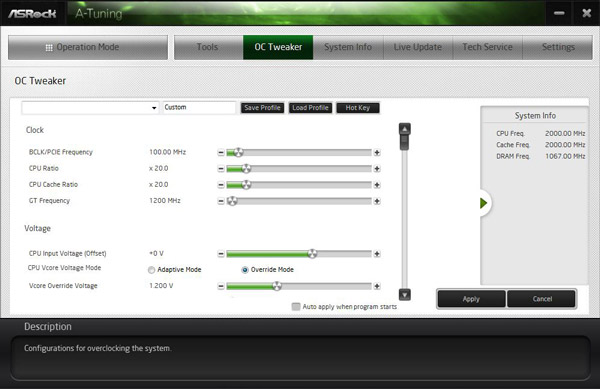
Power consumption …
The power consumption will vary depending upon the hardware and upon the PC load. The current consumption of the test PC with Intel Core i5-4670K CPU, 4GB DDR3-1333 memory, hard disk drive and Cooler Master Silent Pro M 600W test PSU was without overclocking depending upon load: – With Sapphire HD6870 video card the power consumption was between 54.6W idle and 197.1W load. – With onBoard Intel HD Graphics 4600 GPU the power consumption was between 32.4 Watt idle and 92.3 Watt with full load. The power consumption was just approximately 5-7% above the very low consumption values of the previously tested ASRock Z87M OC Formula mainboard.
Result …
The ASRock Z87 Extreme4 LGA1150 DDR3 motherboard offers a very powerful but inexpensive platform for Intel Haswell LGA 1150 processors with an awesome basic equipment, a lot of features and great overclocking options.
The basic equipment of this Z87 Extreme4 motherboard offers altogether five PCI Express slots, nothing less than eight SATA3 ports, one eSATA3 port, up to nine possible USB 3.0 ports, up to eight possible USB 2.0 ports, Gigabit LAN, 7.1 Purity sound, analog sound output over five connectors, digital sound output over an optical SPDIF connector, a very handy switchable HDMI input over a HDMI-In port and dependig on the processor, it offers a graphics output over HDMI-Out, 15-pin D-Sub, DVI-D or DisplayPort.
The ASRock Z87 Extreme4 motherboard can not quite match the enormously versatile OC options of the Z87 OC Formula motherboard, but it offers a lot of very helpful overclocking options and reached even the same BCLK overclocking value in our test. With this great result, it received our Redaktion ocinside.de Overclocking Dream Award 08/2013.
Here you can buy the ASRock Z87 Extreme4 motherboard. *Ad
Special thanks to ASRock for their support.
* All LGA 1150 motherboard reviews since 01.07.2013 are based on an Intel Core i5-4670K CPU, 1x Sapphire HD6870 1024MB ATI Radeon HD6870 PCI Express 2.0 video card, 2x 2048MB Crucial Ballistix Tracer DDR3-1333/PC3-10600 memory modules, Cooler Master Silent Pro M 600W power supply unit and the following software configuration: Microsoft Windows 7 Ultimate, Microsoft Windows Vista Ultimate, SiSoftware Sandra 2013, Futuremark 3DMark11, 3DMark Vantage, 3DMark06 and 3DMark03 (the software is available in the Links & Downloads section). All benchmark results only offer a comparison among themselves for a rough motherboard performance comparison.
Back to the motherboard comparison with all AMD and Intel motherboard reviews !


